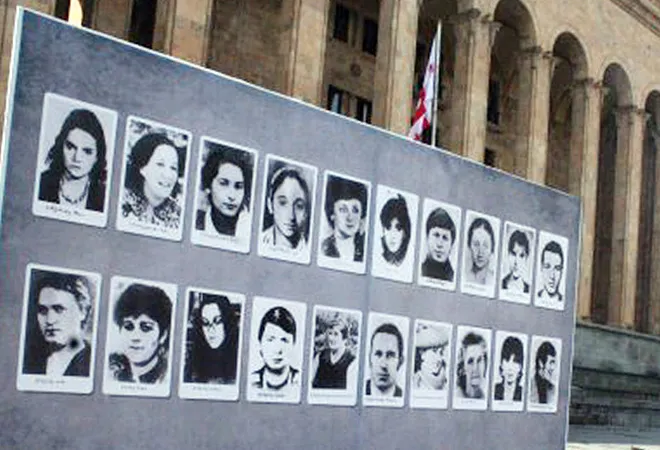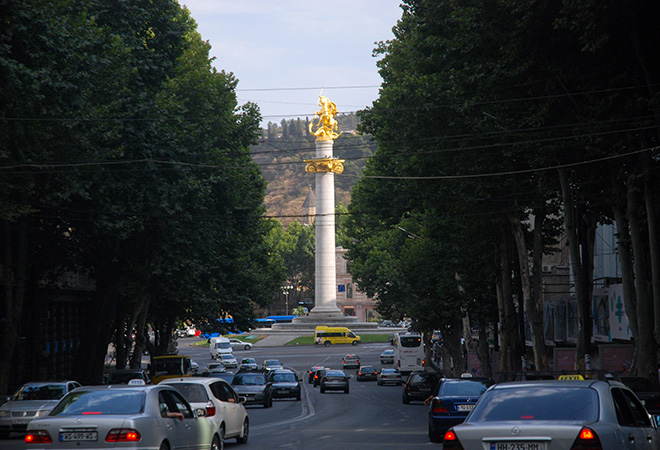
Thirty years ago, in the early hours of 9 April, a tragedy broke out in the centre of Tbilisi, which went down in history as the “night of sapper blades.” Special forces of the Soviet troops, armed with sapper shovels and tear gas, brutally dispersed a peaceful rally. As a result, 21 people died, including 16 women. Eighteen participants of the rally died at the scene, while three more died in the hospital.
In the first hours after the dispersal of the rally, 183 participants were hospitalised. About 300 people were poisoned with gases, 290 were injured, 21 of them with blows of the blades. One was shot in the head. During the month, 4,035 people applied for medical help.
The massacre of 9 April 1989 was a real shock and a moment of truth with many consequences for Georgia and beyond. However, in Georgia, the case of 9 April, characterised by a special drama, was not unique. Similar crises associated with popular unrest and demonstrations had also happened before. Whereas each rebellion was different in circumstance and cause, they set the precedent for the future rebellions. However, the events of 1989 should be highlighted because they left a deep imprint on the fate of modern Georgia and wider area of post-Soviet space.
The importance of the events of 9 April is primarily determined in terms of their influence on shaping of a new Georgian identity. Towards the end of 1980s, Georgian nationalism, repressed by the Soviet totalitarian regime, revived. National sentiments broke out and acquired a political meaning, with the notion of national freedom. The “national awaking” began, especially among the youth and part of the intelligentsia. The process proceeded progressively. However, although many supported, yet until 9 April not everyone believed in the slogans that were heard from the stands of the rally — “Down with the communist regime!”, “Down with Russian imperialism!”, “USSR — Prison of the Peoples!” The tragedy of that night, though, instantly united everyone. Even avid communists from the local communist party nomenklatura lost their arguments and were forced to embrace the new popular spirit. The subsequent referendum and declaration of independence in 1991 were final acts, marking the formation of a new identity based on national self-awareness and distinctiveness, and motivation to defend territorial integrity. The sense of belonging to the Soviet Union began to indulge in oblivion.
The importance of the events of 9 April is primarily determined in terms of their influence on shaping of a new Georgian identity.
The 9 April had significant political consequences not only for Georgia but for the entire Soviet Union. In the context of glasnost, the tragic events in Tbilisi were loudly resonated throughout the Union. The so-called “Sobchak Commission” reported to the Second Congress of People’s Deputies of the USSR the results of the investigation into the circumstances of the tragedy. To the credit of the Commission, it interpreted impartially the revealed facts and found that the brutal dispersal of the demonstration occurred in violation of law and all the blame for human casualties must fall on those who gave the order and executed it. In parallel, photographers and journalists were actively working; they wrote articles and organised photo exhibitions, etc. In the end, a universal public opinion was formed, which in turn inspired democratic forces throughout the Union and in the Soviet Russia itself. Meantime, the 1990 elections to the parliaments of the Union republics showed that these parliaments have the legitimacy that allows them to declare state sovereignty, which they did. So it happened in Russia too. When Russia declared its state sovereignty on 12 June 1990, it became clear that this was the final curtain of the Soviet Union. Indeed, in December 1991, the USSR ceased to exist.
The events of 9 April also gave rise to the so-called “Tbilisi Syndrome.” This syndrome was characterised by the reluctance of military officers and soldiers to take any tactical decisions or even obey orders without a clear trail of responsibility to a higher authority. It arose because of the Soviet leadership’s refusal to take responsibility for the orders to clear the square and the “Sobchak Commission” report’s and Shevardnadze’s criticism of the military in general. “Tbilisi Syndrome” continued to spread in the coming years, especially following events in Baku and Vilnius, and contributed in 1991 to the refusal of soldiers to prevent demonstrations during the August 1991 putsch.
The events of 9 April gave rise to the so-called “Tbilisi Syndrome.” This syndrome was characterised by the reluctance of military officers and soldiers to take any tactical decisions or even obey orders without a clear trail of responsibility to a higher authority.
Against the background of solidarity from the democratically-minded Russian intelligentsia, the strong anti-Soviet and anti-imperial sentiments that arose in Georgia after 9 April initially began to be associated with the Kremlin. However, when it became clear that a significant part of the Communist Party and military elite, as well as the corps of security services, had already migrated to state institutions and agencies of post-Soviet Russia, this latter replaced the Soviet Kremlin as the perceived main antagonist. Indeed, unfriendly and sometimes aggressive actions against independent Georgia, taken during the separatist wars in Abkhazia and South Ossetia in the first years of independence, in fact were largely due to the desire of embittered former Soviet military and security establishment to punish the “ungrateful” Georgians, who by their rebellion in late 1980s set an example to others and eventually contributed to the collapse of the Soviet Union. The motivation for punishment emerged immediately upon disintegration of the Soviet Union when Russia regarded Georgia as an unreliable and disloyal neighbor. Russia’s hostile involvement in Georgia’s conflicts was combined with a financial and economic blockade, which aggravated the already difficult economic situation. Georgia quickly realised that nothing promising should be expected from Russia. Thus, already then, the first seeds of strategic choice, which later was dubbed as country’s pro-Western orientation, were sown. In the first place, this orientation was aimed at protecting oneself from Russia and seeking security guarantees in the West.
 The scene of the 9 April tragedy is a square on Rustaveli Avenue. Source: Jelger — © Flickr/CC BY-NC 2.0
The scene of the 9 April tragedy is a square on Rustaveli Avenue. Source: Jelger — © Flickr/CC BY-NC 2.0
The 9 April left a mark on subsequent development of Russian-Georgian relations. These relationships have always been problematic. The former Soviet military and security elite struggled to put up with the collapse of the Soviet Union and the independence of former vassals of the empire. Having migrated to post-Soviet Russia, these people especially hated “ungrateful” Georgia with its leader Eduard Shevardnadze, who was considered the architect of perestroika. Among them was Vladimir Putin, a native of the collapsed KGB, but now equipped with the powers of the president of post-Soviet Russia. In his understanding, the 9 April had played a role of a powerful earthquake leading to “the greatest catastrophe of the 20th century” — the dissolution of the Soviet Union. This should explain the roots of the confrontation between Russia and Georgia throughout the entire period after the disappearance of the Soviet Union. Quite logically, Russia remains the only country in the world with which Georgia has a negative balance sheet where serious unsettled problems outweigh mutually beneficial agreements.
Russia remains the only country in the world with which Georgia has a negative balance sheet where serious unsettled problems outweigh mutually beneficial agreements.
Another circumstance associated with the 9 April
The scene of the 9 April tragedy is a square on Rustaveli Avenue in front of the Parliament building. This place has seen many instances of the protesters disgruntled with the government seeking a change of policies or governments altogether. Often the protests ended in violence. Examples of such events are: a) The 1956 uprising that took place against Nikita Khrushchev’s intention to invalidate Josef Stalin, then Georgia’s hero; and b) The 1978 major demonstration of the Georgian people against the Soviet regime in response to Communist Party’s attempt to revoke the status of the indigenous Georgian language as the constitutional state language and thus making the Russian language official instead. However, the events of 9 April 1989 finally assigned to this square the function of a magic platform of change. Throughout 1990s and later dozens of mass protests continued to take place in the square often resulting in policy change. An outstanding case of the next large-scale events in this square were mass demonstrations during the Rose Revolution, whereby the government of Mikheil Saakashvili came to power. Ironically, it was precisely against this government that already in 2007 thousands of disgruntled citizens marched on the square. In 2011, a mass protest was repeated. In both cases, the government applied an excessive force, causing widespread resentment and criticism from the international community. In 2012, the fear of the “square syndrome” made Mikheil Saakashvili relocate the Parliament to Kutaisi under the pretext of geographical rebalancing of state institutions. Interestingly, such a move did not justify itself, and even during the absence of Parliament, the square continued to be filled with protesters of all stripes. Today, too, if passing by the Parliament building, one can see the political theatre with tents set up next to the memorial to the victims of 9 April. As always, the protesters hope for the magic power of the country’s most important political altar.
Few days ago, Georgia celebrated the 80th anniversary of the birth of Zviad Gamsakhurdia, the first President of modern Georgia. Under his leadership, Merab Kostava and several young politicians led Georgia along a thorny path through the 9 April tragedy to the restoration of independence. This group of upstart politicians together with the Georgian people wrote perhaps the most important page in the modern history of the country. Since, Georgia has persistently made its way to freedom and prosperity. The road has been long and winding, but the charge of national energy given on 9 April is strong enough to keep moving forward.
The views expressed above belong to the author(s). ORF research and analyses now available on Telegram! Click here to access our curated content — blogs, longforms and interviews.




 The scene of the 9 April tragedy is a square on Rustaveli Avenue. Source: Jelger — © Flickr/CC BY-NC 2.0
The scene of the 9 April tragedy is a square on Rustaveli Avenue. Source: Jelger — © Flickr/CC BY-NC 2.0 PREV
PREV


